Manage Tickets
Click 'Staff Panel' > 'Tickets'
- The tickets area lists all submitted tickets along with their status, priority and assignee
- You can respond to tickets, assign tickets to staff, schedule tickets, view ticket materials and more
- The interface also lets you create a new ticket on behalf of a user
See the following for more help:
- Open the staff panel (See the last link on the left)
- Click 'Tickets' on the left then click 'Open' (to see all open tickets)
- Alternatively, select one of the other ticket categories:
My Tickets
Unassigned
Answered
Overdue
Closed
Scheduled
Paused

- New Ticket: Allows the currently logged-in staff member or admin to create a ticket on behalf of a user. See 'Create a new ticket on behalf of a user' for more information.
- Open: Tickets that are not yet resolved. Click the ticket number to answer, transfer, reassign or schedule the ticket.
- 'Assigned' and 'Answered' tickets may be excluded from this view by configuring options in the 'Ticket Settings and Options' interface.
- My Tickets - Tickets that are assigned to the person who is currently logged-in. Click the ticket number/subject to answer, transfer, reassign, schedule, or register time-spent on a ticket.
- Unassigned - Tickets that have not yet been assigned. Admins can assign tickets to staff by clicking the ticket number then the 'Assign' link. See 'Assign tickets to a staff member' for more details.
- Answered: Tickets for which there has been at least one reply. Click the ticket number to review, reassign, transfer and more.
- Overdue: Tickets that were not closed within the period specified in the SLA. Overdue tickets are automatically closed if set in the 'Ticket Settings and Options' interface.
-
Closed - Tickets that are finished/complete. Click the ticket number to review, reopen, reassign etc.
- Scheduled - Tickets that have a set time by which they should be started and/or finished. The schedule is shown on the staff member's calendar. Click the ticket number to answer, re-assign, transfer, re-schedule, etc.
- Paused - Tickets that are not being worked on at the current time. The ticket can be resumed by the staff member member assigned to the ticket, or by an admin. Click the ticket number then 'Resume' to do this.
- Materials - View material costs and other expenses added to tickets by staff.
Material costs must be
approved by admin. See View
Details of Materials/Expense Items added to Tickets for more details.
The columns you see depend on the filters you have chosen, and you can modify columns by clicking the 'Customize Columns' button. The following is a list of ALL possible columns:
- Ticket - The number assigned to the ticket. Click the ticket number to open the 'Ticket Details' screen.
- Tickets raised via the web portal
- Tickets sent in by email
- Tickets created by staff members on behalf of users
- Last Update Date - Date and time the ticket was created, re-opened, updated or closed.
- Subject - A brief description of the issue.
- The subject is usually chosen by the user or staff member who created the ticket.
- Tickets that were auto-created by another C1 module will simply state the name of the module responsible. For example, 'RMM Generated Ticket'.
- The
icon indicates that one or more collaborators have been added to the ticket CC list
- From - The name of the user who created the ticket, or on whose behalf the ticket was created.
- Priority - The criticality of the ticket.
- Ticket priority depends on the settings in 'Ticket Category', 'Department' and 'Ticket Filters'.
- Tickets sent in by email can have their priority set by the sender's mail client. This has to be enabled in 'Admin Panel' > 'Settings' > 'Emails'.
- If no custom settings apply, then tickets are given the default priority of 'Normal'.
- Device Name - The endpoint which generated the ticket.
- This is only shown for tickets auto-created by Endpoint Manager.
- Click the device name to view more details about the device.
- See https://help.comodo.com/topic-399-1-786-10175-View-Summary-Information.html if you need more information about the device details screen.
- Assigned to - The text of this column header depends on the ticket status. For example, for 'Unassigned' tickets the column header will be 'Department'.
- Assigned to: The name of the staff member to whom the ticket is assigned
- Department: The name of the department to which the ticket is assigned
- Customer - The company of the user who raised the ticket
- Source - The channel through which the ticket was created. Possible channels are:
Phone
Other
Web
API
- Ticket Category - The help topic on which the user requested support. See Ticket Categories for more on this.
- Department - The department in your organization to which the ticket is assigned
- Due Date - The date and time by which the ticket should be closed.
- Closed By - Staff member who closed the ticket.
- Status- Ticket progress. Possible values are:
Open
Answered
Overdue
Closed
Paused
- Overdue - Indicates the ticket was not closed by its due date.
- Answered - Indicates whether or not a response has been given to the user.
- Asset - The product, service, or item that the ticket concerns.
- Category (Ticket Type) - Type of request that the ticket concerns. The possible values are:
Alert
Order
Problem
- Sub-category - Specific issue type as chosen by the person who created the ticket. For example, 'Overheating' may be a sub-category of 'Problem'.
- Scheduled Time - Date and time at which the ticket will be started.
- First Reply - Date and time of the first response to the user.
- Click the 'Customize Columns' button:
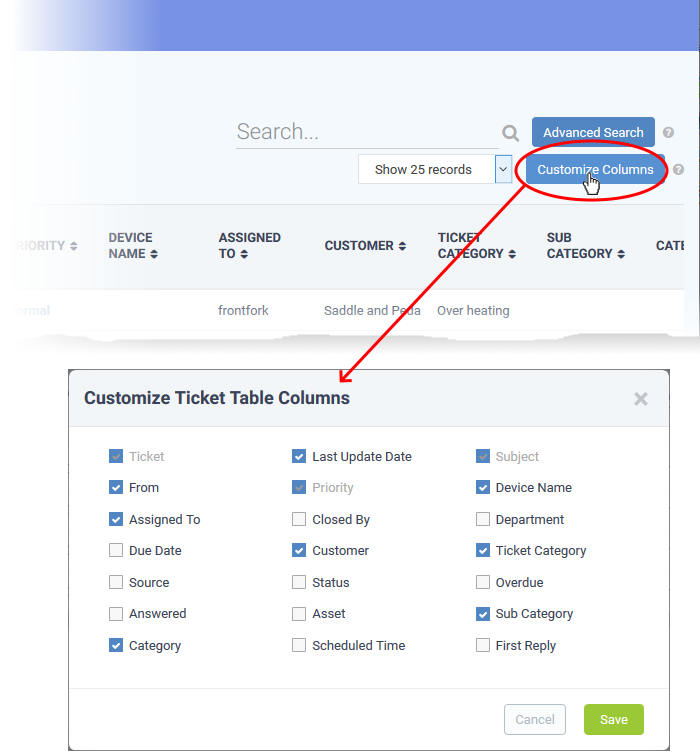
- Use the check-boxes to enable or disable columns as required
- Certain columns are mandatory for certain views
- Click 'Save' to add/remove the selected columns to the list
View a short summary of a ticket
- Place your mouse cursor over a ticket to view brief details:
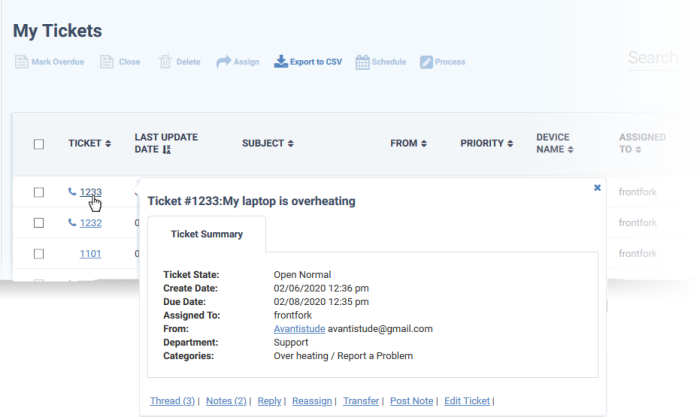
The links at the bottom allow staff members to manage the ticket. See 'Ticket Details' for more details.
Assign tickets to a staff member
- Admins can assign/reassign individual or multiple tickets to a staff from the 'Tickets' interface.
- The ticket will appear in the 'My Tickets' area of the person to whom it is assigned.
Assign tickets
- Open the 'Staff' panel (see last link on the left)
- Click 'Tickets' then a ticket type ('Open', 'Unassigned', 'Overdue', etc)
- Select one or more tickets and click 'Assign' at the top
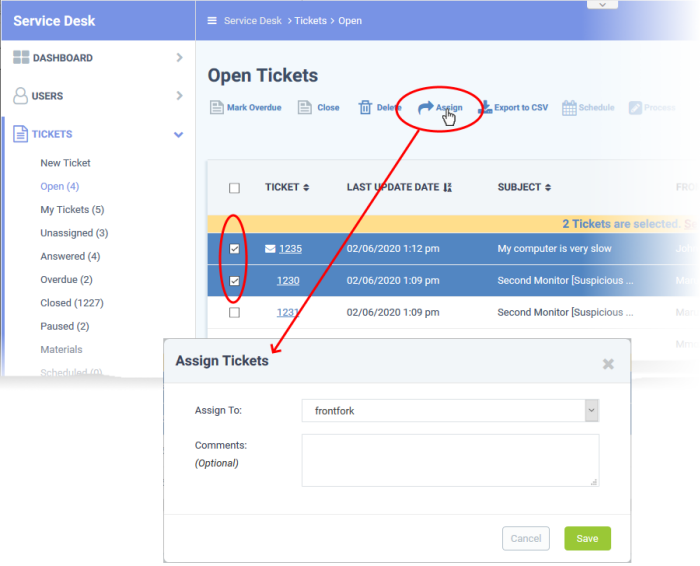
- Assign to - Select the admin/staff member to whom you want to assign the ticket
- Comments (Optional) - Enter task notes, instructions, or a reason you assigned the ticket to this person. The comment is added as an internal note on the ticket.
- Click 'Save'
- Scheduled tickets are useful for tasks that will start at a set time in the future. For example, a site visit or scheduled maintenance.
- The schedule is added to the calendar of the currently logged-in admin/staff.
- The ticket is automatically assigned to the person who creates the schedule, even it it is currently assigned to someone else.
Create a schedule for a ticket
- Open the 'Staff' panel (see last link on the left)
- Click 'Tickets' then a ticket type ('Open', 'Unassigned', 'Overdue', etc)
- Select a ticket and click 'Schedule' at the top
- The calendar for the currently logged-in admin/staff opens. The ticket details are shown on the title bar:
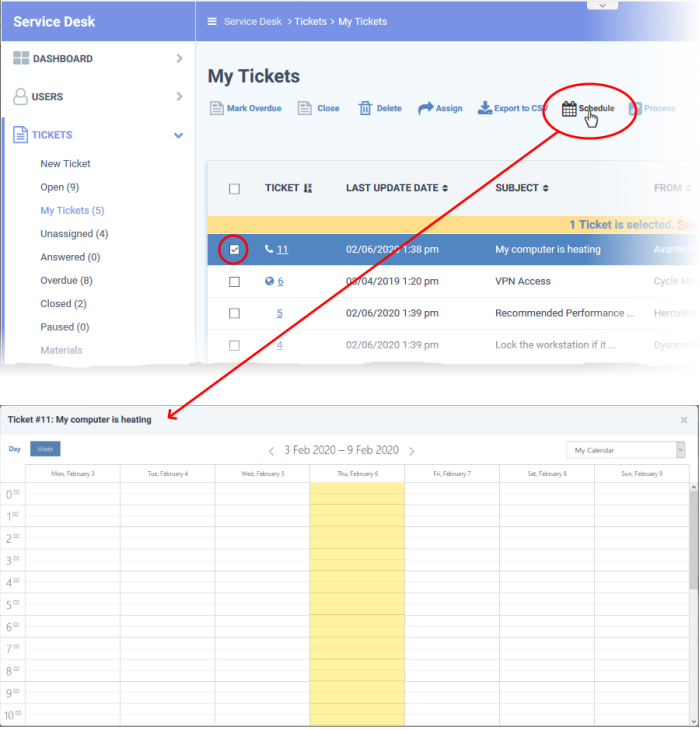
- The current week is shown by default. Use the '>' button to move to the next week / day
- Double-click the cell that represents the time slot you want for the ticket
- Enter a short description of the task.

- Click
the check-mark
 to save the schedule
to save the schedule
- The appointment is added to the calendar. You can view your calendar from the 'My Calendar' interface. See Manage Calendars for more details.
- The ticket is moved to the list under the 'Scheduled' category on the left.
Edit, reassign, or add collaborators to a ticket
- The 'Process' feature lets you reassign a ticket, update user information, change ticket category/department, add collaborators, and more.
- This
feature is available for all ticket categories except closed
tickets.
Use the process option
- Open the 'Staff' panel (see last link on the left)
- Click 'Tickets' then a ticket type ('Open', 'Unassigned', 'Overdue', etc)
- Select a ticket and click 'Process' at the top:


User Information
- User name: The person who submitted the ticket or for whom the ticket was created. This is is pre-populated. Click 'Change' to select a different user.
- Issue Summary: Brief description of the issue. Update if required.
- Issue
Description: Ticket description provided by the creator of the
ticket. This is not editable.
Ticket Information
- Ticket Source: The channel through which the ticket was created. The options available are 'Phone', 'Email', 'Web', 'API' and 'Other'. This is pre-populated and can be updated if required
- Category: The help topic under which this ticket falls. This is pre-populated and can be updated if required. See 'Ticket Categories' for more details.
- Sub Category: Specific issue type as chosen by the person who created the ticket. For example, 'Overheating' may be a sub-category of 'Problem'.
- Department: The department to which to the ticket is currently assigned. This is pre-populated and can be updated if required. See 'Departments' for more details.
- SLA Plan: The service level plan associated with the ticket. Use the drop-down menu to change the plan if required. The option chosen here will prevail even if the SLA plan for the 'Ticket Category' and 'Department' is different.
- Time Spent: Cumulative time spent on the ticket by all contributing staff members. This total includes time recorded automatically during a session and time manually added by administrator/staff.
- Due Date: The date and time by which the ticket should be closed. Change the date and time if required. This will override the date generated by default.
-
Resolution: A description of the fix/solution. This could also be a description of the steps taken so far, and those that remain, in order to bring about a fix. This is set by the staff member attending to the ticket. Change the resolution if required.
Assign the Ticket
- Assignee: Person who is currently responsible for the ticket. You can change the assigned staff member if required.
- Comments: Enter instructions for the assignee or reasons for the assignment.
Collaborators
- Add people who also worked on the ticket as additional recipients for ticket updates.
- Click 'Add New Collaborator' to associate new or existing users with the ticket.
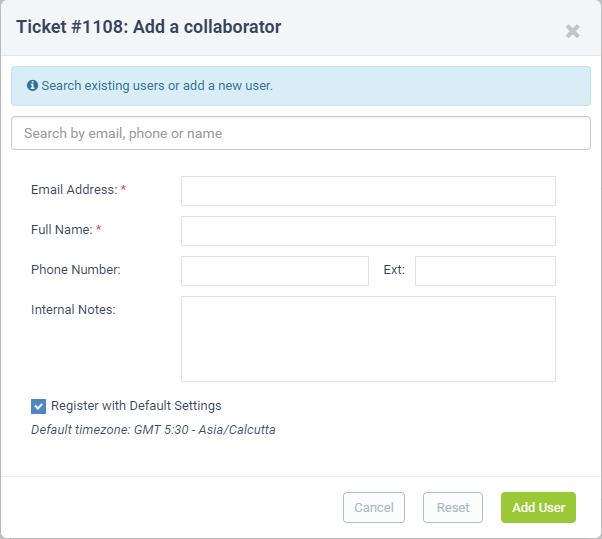
- Type the first few letters of a username/email address in the search box. Select the user from the suggestions.
- Enter the email address, full name and other details.
- Click 'Add User'.
- Repeat the process to add more collaborators.
- Click the 'Process' button after you have made your changes. The ticket will be updated per the new details.
View ticket materials/expense items
- Staff can add materials and expense items to a ticket if they were required to resolve the issue.
- Admins must approve these items. Once approved, they will be billed to the customer.
- The 'Materials' screen lets you all view materials / expenses added to the tickets, along with their approval status.
- Click 'Tickets' on the left then select 'Materials':

- Material Name - The name of the material or the expense item.
- Ticket # - The number of the ticket to which the material or expense item was added. Click the ticket number to view or update the ticket. See Ticket Details for more details.
- Cost - The cost of the material/expense item as entered by the staff member.
- Date Added - The date and time at which the item was added to the ticket.
- Last Updated - The date and time at which the item details were last updated by the staff member.
- Status - Indicates whether the material/expense was approved by the administrator. The possible states are:
- Awaiting - The expense item has been added to a ticket but has not yet been approved by an administrator.
- Approved - The expense item has been added to a ticket and approved for billing by an administrator.
- Rejected - The expense item has been rejected by an administrator.
- You can close tickets if all tasks are complete. All billable time will be assigned to the customer.
- If required, you can also reopen closed tickets.
Close tickets
- Open the 'Staff' panel (see last link on the left)
- Click 'Tickets' then a ticket type ('Open', 'Unassigned', 'Overdue', etc)
- Select the tickets you want to close
- Click 'Close'

- Enter the resolution message for closing the ticket.
- Click 'Save'.
The ticket is updated
with the resolution message. The ticket is moved to the 'Closed'
category.
Reopen closed tickets
- Open the 'Staff' panel (see last link on the left)
- Click 'Tickets' then select 'Closed'
- Select the tickets you want to reopen
- Click 'Reopen'
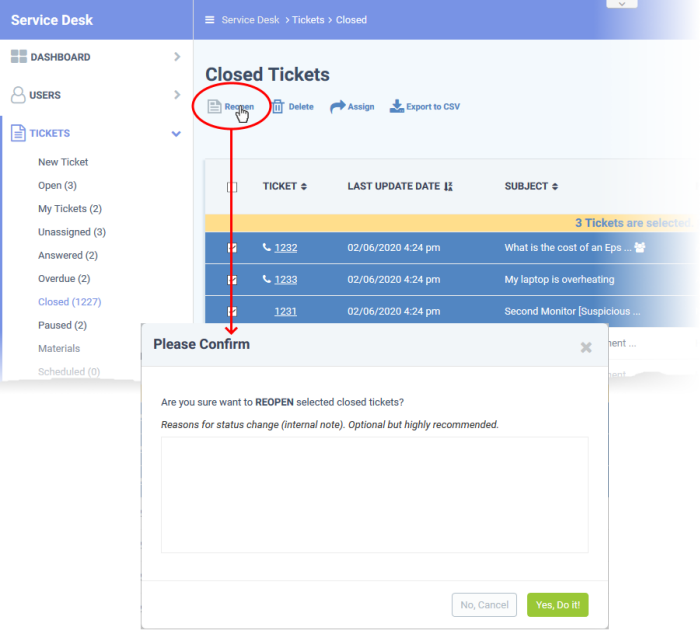
- Enter the reason for reopening the tickets and click 'Yes, Do it!'
- The message is added as internal note to the tickets
- The
status of the tickets is changed to 'Open' and automatically
assigned to the currently logged-in staff / admin.
Create a new ticket on behalf of a user
- Staff and admins can create tickets on behalf of users from the tickets interface. You might want to do this if, for example, a customer described their issue over a phone-call.
- Staff can also create tickets for issues that they resolved, but which had no ticket.
- Select 'Work done in the past' to enable this option.
- Tickets for completed tasks are given a status of 'Closed'.
There are two ways to create a ticket for a user:
1. Create a ticket by selecting a user from the directory – Click 'Staff Panel' > 'Users' > 'User Directory' > click on a user > 'User Tickets' > 'Create New Ticket'. The new ticket form appears with the user details pre-populated. See Create a new ticket on behalf of a user in the section Manage Users if you need help with this.
2. Create
ticket for a new user
from the 'Tickets' interface -
Click 'Staff Panel' > 'Tickets' > 'New Ticket'. The rest
of this section explains creating a new ticket from the 'Tickets'
interface.
- Open the 'Staff' panel (see last link on the left)
- Click 'Tickets' then select 'New Ticket'
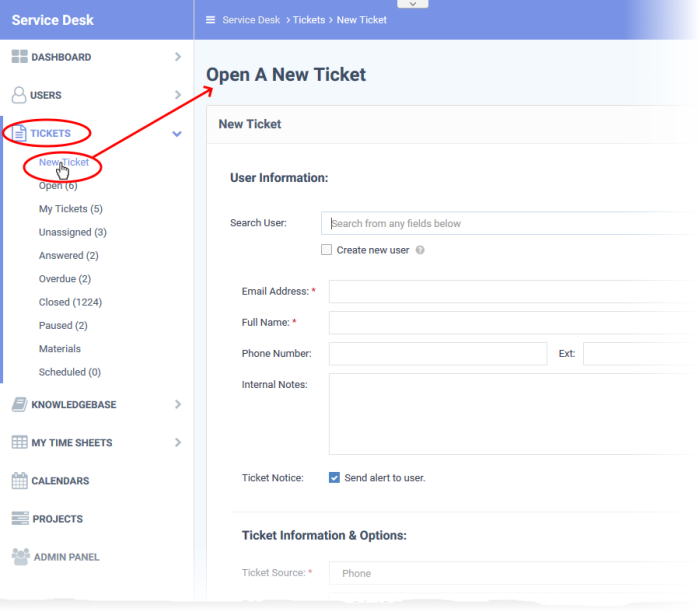
The new ticket form contains the following sections:
- User information - Details about the user on whose behalf of you are creating the ticket
- Ticket information and options - Ticket category, SLA plan, due date, assigned staff member, and more.
- Backdated ticket - Specify whether the work is already complete.
- Ticket details - Issue description, priority, asset type, and more
- Response - Initial reply sent to the user
- Internal note - Notes regarding the issue for internal references

Search user - Create ticket for an existing user. Start typing their user name or email. Choose the user from the suggestions.
Create new user - Create a new user. The ticket will be associated with this new user.
- Enter the email address, full name and phone number of the user. Add any notes about the user in the respective fields. The internal notes are only visible to admins/staff.
- New users are added as guests. You can associate users with customers in the 'User Directory' interface.
- See Manage Users if you need help with this.
Ticket Notice - Sends an email to the user which informs them that the ticket has been created.

- Ticket Source: Select the channel through which you received the request from the user. The options are 'Phone', 'Email' and 'Other'.
- Category: Select the help topic under which the ticket falls. Depending on the ticket category selected, more forms may be included in the ticket. See 'Ticket Categories' and 'Forms' for more details.
- Schedule Time: Choose a date in the future when work on the ticket should begin. The schedule will be added to your calendar.
- Department: The department is auto-selected when you choose the ticket category. You can choose a different department if you want.
- SLA Plan: The service level plan associated with the ticket. This is determined by the ticket category. Use the drop-down menu to change the plan if required.
- Due Date: The date and time by which the ticket should be closed. A default due date is auto-generated based on the ticket category, department and SLA. You can change the date and time as required. This will override the date generated by default.
- Assign To: Choose the staff member to whom you want to assign the ticket. This assignee stands even if the 'Agent' for the category is different.

- Work done in the past - Enable this if the ticket is for work that has already completed. The ticket is automatically given a status of 'Closed'.
- Enter the task start and end dates in the spaces provided.
- Make sure the end date is before the 'Due Date' entered elsewhere on the form.

- Issue Summary: Create a one-line description of the issue.
- Issue Details: Enter a more detailed description of the issue.
- Priority Level: Ticket criticality. This is determined by the ticket category. Change the priority if required.
- The option chosen here will prevail even if the 'Priority' for the selected 'Ticket Category' is different.
- Staff can change the priority while the ticket is in-progress. SeeTicket Details for more details.
- See Appendix 2 - Ticket Priorities if you need help with priorities.
- Asset Type: The type of item that the ticket concerns. For example, 'Workstation', 'Server', 'Printer', 'Mobile'.
- Type: The broad issue category. The options are 'Alert', 'Order' and 'Problem'.
- Sub type: Type a sub-set if you wish to further refine the 'Type'. Sub-types can be used to add more details about the category and asset type. For example, 'Overheating' may be a sub-category of a 'Problem' with a ‘Server’.

- It is optional to create a response. Type any response you wish to send to the user in the text field provided. Responses will be automatically sent to the user after you click 'Open'.
- Canned Response: Select if you wish to want to send a pre-defined response to the ticket.
Any canned responses you select are added to the 'Response' text field. You are free to edit and/or add text to complement the canned response.
You can add multiple canned responses to build a more complete answer. For example, you might add the following 3 canned responses to a single response - 'Acknowledgment', 'Ticket has been queued', 'Contact details'. Please enter a line space between each canned response for formatting reasons.
- See Canned Responses for help to create and manage canned responses.
- Attachments: Click the 'Browse' button to add relevant attachments to the ticket.
- Ticket Status:If enabled, the ticket is closed immediately after saving. You must have entered a response for this to work (see the descriptions above).
- Resolution:
- Enabled - The answer/response is considered as resolving the issue.
OR
- Click 'Add Resolution', if you want to specify a different resolution statement.
- Signature:
Internal Note
- None - Means you can either send with no signature OR type a custom signature in the editor.
- Signature' – Use the signature of the department to which the ticket is assigned. See 'Staff Members' and 'Department' for more details about adding signatures.
- Enter comments, reminders and remarks to staff who might work on the ticket. Internal notes are only visible to admins/staff, and not to the user.
- Click 'Open' to create the ticket on behalf of a user.
- The ticket is added to the 'Tickets' interface. You or the staff member to whom the ticket is assigned can view/update the ticket by clicking the subject or ticket number.
- Open the 'Staff' panel (see last link on the left)
- Click 'Tickets' then a ticket type ('Open', 'Unassigned', 'Overdue', etc)
- Select the tickets you want to remove from Service Desk
- Click 'Delete'
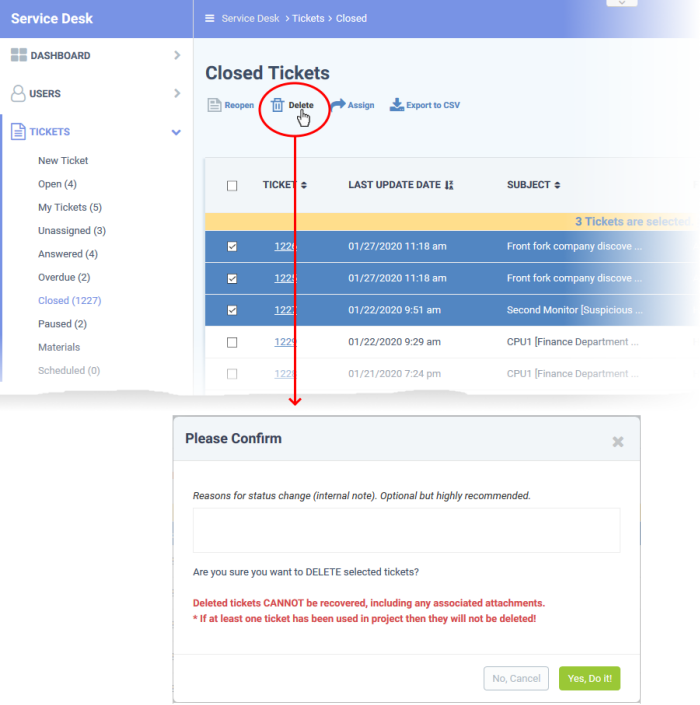
- Enter the reason for removing the tickets (optional).
- Click 'Yes, Do it!' to confirm removal.
- Note - Deleted tickets cannot be recovered.
You can save the list of tickets as a comma separated value (CSV) file for archiving and analysis purposes.
Generate a tickets report
- Open the 'Staff' panel (see last link on the left)
- Click 'Tickets' then a ticket type ('Open', 'Unassigned', 'Overdue', etc)
- Click the 'Export' link at the top
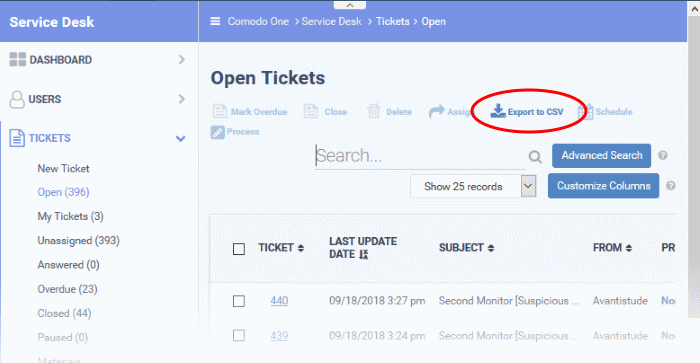
.csv files are best viewed in
spreadsheet applications like Microsoft Excel and OpenOffice Calc.
Sorting and Filtering Options in the 'Tickets' Interface
Sorting items
- Click a column header to sort items in ascending/descending order
Search Options
You can run a simple search or an advanced search on tickets.
Simple Search
- The 'Search' field lets you filter tickets by the following criteria:
- Ticket ID
- User name
- Organization
- Device Name
- Start typing your search term and tickets matching your criteria will be automatically displayed.
- To display all tickets, clear the search field (or simply click the ticket category link on the left).
Advanced Search
- 'Advanced Search' lets you filter tickets based on preset criteria
- Click the 'Advanced Search' button

- Enter/select the parameters that you want to use as search criteria.
- Click the 'Reset' button to clear the fields.
- Click the 'Search' button after filling the required search parameters.
The number of tickets that matches the search parameters will be displayed at the top of the screen.
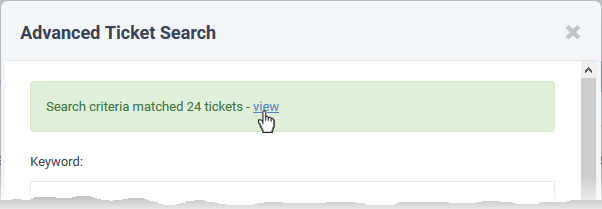
- Click the 'view' link to see the list of tickets which match the search criteria
- To view all tickets again, click the respective ticket category under 'Tickets' on the left



